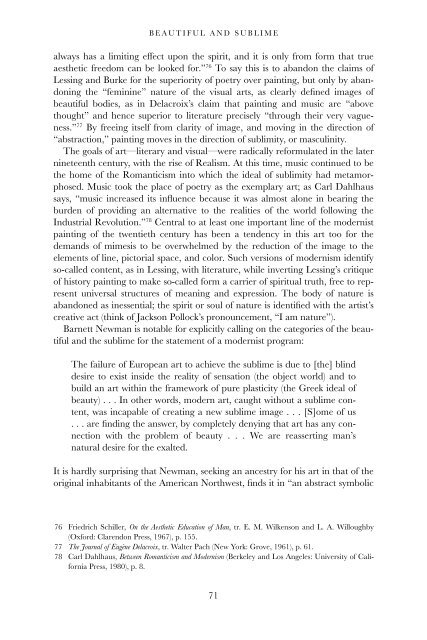Art in its Time: Theories and Practices of Modern Aesthetics
Art in its Time: Theories and Practices of Modern Aesthetics
Art in its Time: Theories and Practices of Modern Aesthetics
Create successful ePaper yourself
Turn your PDF publications into a flip-book with our unique Google optimized e-Paper software.
BEAUTIFUL AND SUBLIME<br />
always has a limit<strong>in</strong>g effect upon the spirit, <strong>and</strong> it is only from form that true<br />
aesthetic freedom can be looked for.” 76 To say this is to ab<strong>and</strong>on the claims <strong>of</strong><br />
Less<strong>in</strong>g <strong>and</strong> Burke for the superiority <strong>of</strong> poetry over pa<strong>in</strong>t<strong>in</strong>g, but only by ab<strong>and</strong>on<strong>in</strong>g<br />
the “fem<strong>in</strong><strong>in</strong>e” nature <strong>of</strong> the visual arts, as clearly def<strong>in</strong>ed images <strong>of</strong><br />
beautiful bodies, as <strong>in</strong> Delacroix’s claim that pa<strong>in</strong>t<strong>in</strong>g <strong>and</strong> music are “above<br />
thought” <strong>and</strong> hence superior to literature precisely “through their very vagueness.”<br />
77 By free<strong>in</strong>g <strong>its</strong>elf from clarity <strong>of</strong> image, <strong>and</strong> mov<strong>in</strong>g <strong>in</strong> the direction <strong>of</strong><br />
“abstraction,” pa<strong>in</strong>t<strong>in</strong>g moves <strong>in</strong> the direction <strong>of</strong> sublimity, or mascul<strong>in</strong>ity.<br />
The goals <strong>of</strong> art—literary <strong>and</strong> visual—were radically reformulated <strong>in</strong> the later<br />
n<strong>in</strong>eteenth century, with the rise <strong>of</strong> Realism. At this time, music cont<strong>in</strong>ued to be<br />
the home <strong>of</strong> the Romanticism <strong>in</strong>to which the ideal <strong>of</strong> sublimity had metamorphosed.<br />
Music took the place <strong>of</strong> poetry as the exemplary art; as Carl Dahlhaus<br />
says, “music <strong>in</strong>creased <strong>its</strong> <strong>in</strong>fluence because it was almost alone <strong>in</strong> bear<strong>in</strong>g the<br />
burden <strong>of</strong> provid<strong>in</strong>g an alternative to the realities <strong>of</strong> the world follow<strong>in</strong>g the<br />
Industrial Revolution.” 78 Central to at least one important l<strong>in</strong>e <strong>of</strong> the modernist<br />
pa<strong>in</strong>t<strong>in</strong>g <strong>of</strong> the twentieth century has been a tendency <strong>in</strong> this art too for the<br />
dem<strong>and</strong>s <strong>of</strong> mimesis to be overwhelmed by the reduction <strong>of</strong> the image to the<br />
elements <strong>of</strong> l<strong>in</strong>e, pictorial space, <strong>and</strong> color. Such versions <strong>of</strong> modernism identify<br />
so-called content, as <strong>in</strong> Less<strong>in</strong>g, with literature, while <strong>in</strong>vert<strong>in</strong>g Less<strong>in</strong>g’s critique<br />
<strong>of</strong> history pa<strong>in</strong>t<strong>in</strong>g to make so-called form a carrier <strong>of</strong> spiritual truth, free to represent<br />
universal structures <strong>of</strong> mean<strong>in</strong>g <strong>and</strong> expression. The body <strong>of</strong> nature is<br />
ab<strong>and</strong>oned as <strong>in</strong>essential; the spirit or soul <strong>of</strong> nature is identified with the artist’s<br />
creative act (th<strong>in</strong>k <strong>of</strong> Jackson Pollock’s pronouncement, “I am nature”).<br />
Barnett Newman is notable for explicitly call<strong>in</strong>g on the categories <strong>of</strong> the beautiful<br />
<strong>and</strong> the sublime for the statement <strong>of</strong> a modernist program:<br />
The failure <strong>of</strong> European art to achieve the sublime is due to [the] bl<strong>in</strong>d<br />
desire to exist <strong>in</strong>side the reality <strong>of</strong> sensation (the object world) <strong>and</strong> to<br />
build an art with<strong>in</strong> the framework <strong>of</strong> pure plasticity (the Greek ideal <strong>of</strong><br />
beauty) . . . In other words, modern art, caught without a sublime content,<br />
was <strong>in</strong>capable <strong>of</strong> creat<strong>in</strong>g a new sublime image . . . [S]ome <strong>of</strong> us<br />
. . . are f<strong>in</strong>d<strong>in</strong>g the answer, by completely deny<strong>in</strong>g that art has any connection<br />
with the problem <strong>of</strong> beauty . . . We are reassert<strong>in</strong>g man’s<br />
natural desire for the exalted.<br />
It is hardly surpris<strong>in</strong>g that Newman, seek<strong>in</strong>g an ancestry for his art <strong>in</strong> that <strong>of</strong> the<br />
orig<strong>in</strong>al <strong>in</strong>habitants <strong>of</strong> the American Northwest, f<strong>in</strong>ds it <strong>in</strong> “an abstract symbolic<br />
76 Friedrich Schiller, On the Aesthetic Education <strong>of</strong> Man, tr. E. M. Wilkenson <strong>and</strong> L. A. Willoughby<br />
(Oxford: Clarendon Press, 1967), p. 155.<br />
77 The Journal <strong>of</strong> Eugène Delacroix, tr. Walter Pach (New York: Grove, 1961), p. 61.<br />
78 Carl Dahlhaus, Between Romanticism <strong>and</strong> <strong>Modern</strong>ism (Berkeley <strong>and</strong> Los Angeles: University <strong>of</strong> California<br />
Press, 1980), p. 8.<br />
71
















